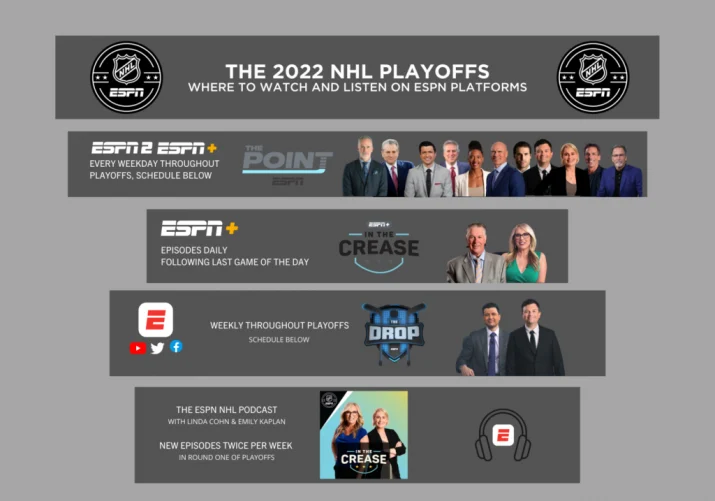On the Ice Again After Nearly Two Decades, ESPN Continues To Innovate for 2022 Stanley Cup Playoffs
Mics on players, camera operators on skates, SupraCam help put the viewer in the rink
Story Highlights
For the first time in about two decades, ESPN is back on the ice for the NHL Stanley Cup Playoffs. And, after a regular season filled with technical innovations and unique production elements, ESPN’s operations and tech crews are primed to kick it up yet another notch during the march to the Stanley Cup Final.
 “We are thrilled to have brought back the NHL to ESPN this year and are looking forward to capping off this historic season with action-packed coverage of the playoffs,” says Erin Orr, senior manager, NHL remote operations, ESPN. “The through line for ESPN’s first NHL season in over two decades has been a commitment to hockey fans everywhere. Each production brought viewers not just what they expected, but what they didn’t even know they wanted.
“We are thrilled to have brought back the NHL to ESPN this year and are looking forward to capping off this historic season with action-packed coverage of the playoffs,” says Erin Orr, senior manager, NHL remote operations, ESPN. “The through line for ESPN’s first NHL season in over two decades has been a commitment to hockey fans everywhere. Each production brought viewers not just what they expected, but what they didn’t even know they wanted.
“Outstanding audio and technical expertise by ESPN’s operations and tech crew made the unexpected possible,” she continues, “proving that the NHL and fans are back where they belong. The team has worked tirelessly throughout the year to get us to the playoffs. We are ready for the puck to drop.”
Audio, Video Tech: A Whole New Way To Cover Hockey
ESPN deployed a bevy of new technologies this year for its NHL coverage on both the audio and video side and will look to use them even more during its playoff run. Highlights include a mirrorless, shallow–depth-of-field, MōVI-stabilized camera operated on skates; a SupraCam four-point flyover system; and mics embedded in player pads and both nets.
Audio was a priority in bringing fans onto the ice, with 5.1 surround sound used in new and sport-specific ways. The team installed a wireless three-mic array in each net to create a hyper-localized surround-sound environment at each crease, bringing an explosive dynamic to puck and stick action in both live broadcast and replays.
Fans were given the opportunity to experience what it would be like to skate alongside their favorite athletes, thanks to a mic-embedding system inside player pads. Additionally, players wore wireless lavalier mics and IFBs, enabling two-way interactions with reporters during warmups.
In terms of cameras, an operator on skates with a mirrorless, shallow–depth-of-field, MōVI-stabilized camera provided close-up access to players throughout warmups, anthems, and stoppages. Meanwhile, the SupraCam four-point flyover system offered a dramatic aerial angle that was boosted further by virtual graphics on the camera with real-time tracking by Unreal Engine Technology.
Also new this year was real-time interaction between ESPN’s onsite commentators and ex-referee Dave Jackson, facilitated through a newly built studio in the NHL Toronto replay room.
 “Honoring the [rights] deal and hockey fans all over the world, the operations and tech crew had a goal to bring the on-ice experience inside viewers’ homes by capturing one of the world’s highest-speed sports with clarity and precision,” says ESPN Senior Operations Specialist Jeff Werner. “Over the course of 100 games — 75 airing on ESPN+ and 25 across linear networks — the team executed their goal through an elevation of audio, camera coverage, and studio add-ons.”
“Honoring the [rights] deal and hockey fans all over the world, the operations and tech crew had a goal to bring the on-ice experience inside viewers’ homes by capturing one of the world’s highest-speed sports with clarity and precision,” says ESPN Senior Operations Specialist Jeff Werner. “Over the course of 100 games — 75 airing on ESPN+ and 25 across linear networks — the team executed their goal through an elevation of audio, camera coverage, and studio add-ons.”
With 12 first-round games on ESPN and ESPN2 over the opening three days of the playoffs (which began Monday), ESPN has already deployed several next-gen production elements, and that number will increase as the playoffs progress.
“The NHL on ESPN production models will grow as each round takes place,” says ESPN Remote Operations Coordinator Carson Kenney. “The goal is to build momentum to the Stanley Cup Final through a variety of technology enhancements.”
First-Round Ops: Mixed EWF, REMI Pro, Onsite Production
During the first round, ESPN will be deploying the Enhanced World Feed (EWF) model for games taking place in Canada and a mix of REMI Pro and full onsite truck-based productions for games in the U.S.
ESPN has a total of eight ops teams tackling 12 sites throughout the eight first-round series. In addition to the EWF shows in Canada, ESPN has four full onsite production sites and multiple REMCO (remote coordination) sites. NEP Group and Game Creek Video will provide all trucks throughout the playoffs, and ESPN and Turner have worked together with both facilities providers to devise a plan to cover potentially 56 first-round games with 12 mobile units.
Games taking place in Toronto, Calgary, and Edmonton will be EWF productions in which ESPN will work closely with local RSNs and Canadian rightsholder Sportsnet.
“ESPN is working hand in hand with the RSNs and Sportsnet to ensure the best broadcast for everyone,” says Orr. “Communication has been taking place daily with the league to help facilitate show specs, resources, and all onsite logistics.”
Looking Back, Looking Ahead: Ops Team Reflects on the Return to the Ice
With the first regular season in the rearview mirror and first Stanley Cup Final since 2004 on the horizon, Orr and her team are taking a moment to reflect on the NHL’s grand return to ESPN.
“The return of the NHL to ESPN has been a true team effort throughout the entire year through multiple functional groups within the company,” says Orr. “The team effort starts at 5:00 in the morning as ESPN’s operations and tech crew is prepping for a night of NHL coverage. While setting up, a crew member may remember similar mornings from their youth-hockey days: an early-morning ice time, a parent digging the car out from last night’s nor’easter, the Zamboni’s glassy ice trail. No matter the time spent apart, hockey cannot be forgotten. ESPN hasn’t forgotten.”
